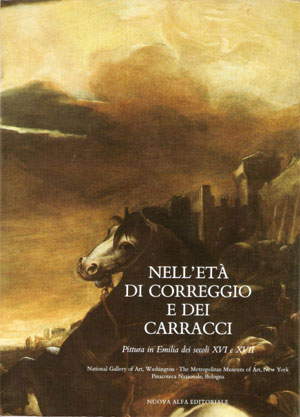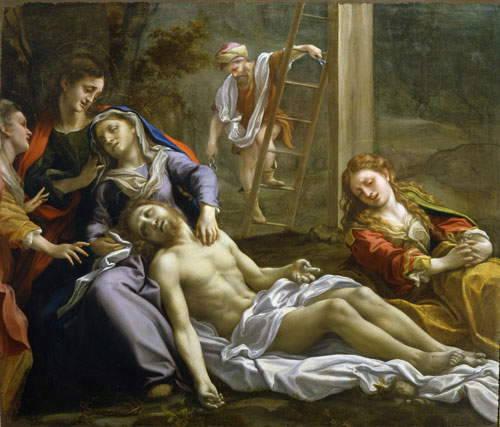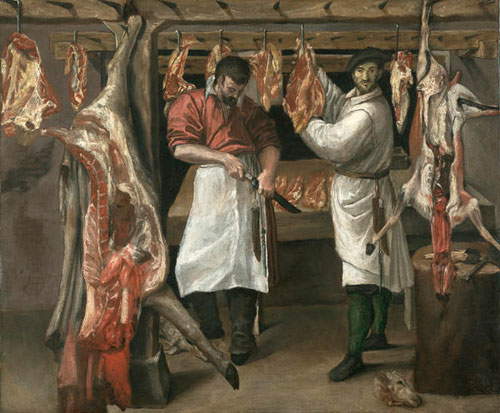Andrea Emiliani is one of the most eminent figures in the history of Italian art: a great scholar, a pupil of Roberto Longhi and Francesco Arcangeli, he is also known for having been an excellent superintendent for the cultural heritage of Bologna, Ferrara, Forlì and Ravenna, as well as director of the Pinacoteca Nazionale in Bologna. In April 2011, on the occasion of his 80th birthday, the Giornale dell’Arte obtained an interview from him chronicling his entire long career. The journalist, Giovanni Pellinghelli del Monticello, rightly recalled how Andrea Emiliani was still remembered as “the protagonist of the season of the great exhibitions dedicated to Bolognese art.” Andrea Emiliani, responding, talked about how one of the best exhibitions held in the past in Bologna had come about, his Nell’età del Correggio e dei Carracci.
 |
| Catalog of the exhibition Nell’età del Correggio e dei Carracci. |
The exhibition opened in Bologna on September 10, and was held at two venues: the Pinacoteca Nazionale and the Museo Civico Archeologico. The exhibition, which lasted exactly two months and ended on November 10, 1986, would then leave the city of Bologna in the following months to go “on tour” to Washington (from December 19, 1986 to February 16, 1987) and New York (from March 26 to May 24, 1987). The Bologna stop was a huge success: in just two months, one hundred thousand people crowded the rooms of the two venues that housed the exhibition. The exhibition’s intent was to retrace the milestones of Emilian painting between the sixteenth and seventeenth centuries, with a focus on what were considered the region’s main hubs: Parma (Correggio, Parmigianino), Ferrara (Dosso Dossi and Bastianino) and Bologna (the Carraccis, Guido Reni, Guercino, Domenichino, Francesco Albani).
 |
| Parmigianino, Antea (c. 1530-1535; Naples, Museo Nazionale di Capodimonte) |
 |
| Correggio, Lamentation over the Dead Christ (c. 1524; Parma, National Gallery) |
From the Parmesan experiences would unravel the thread that would later lead to the birth of the Carracci school: the exhibition insisted in particular on how Parmigianino’s example had been important for Ludovico Carracci and how, on the other hand, Correggio’s refinement would mark Annibale Carracci’s classicism. Indeed: Correggio was seen as a fundamental starting point for later Emilian experiences. From Carracci’s classicism would later spring the seventeenth-century Bolognese school, with such preeminent figures as Guido Reni (discussed in connection with the 1954 exhibition), Domenichino and Guercino. Although the exhibition focused, as mentioned earlier, mainly on the classicist strand, it would certainly have been incomplete had it not examined the more distinctly naturalist component of the Carracci school, and of Emilian art in general: naturalism was represented by exceptional loans, such as Annibale Carracci’s Butcher’s Shop from the Kimbell Art Museum in Forth Worth, and also some paintings by Caravaggio, whose painting has always been related to that of Annibale Carracci, although the conclusions arrived at over the years have never been unambiguous or certain.
The exhibition succeeded not only in its intent to explode international interest in Emilian painting in its entirety, an interest in any case that had already arisen as a result of the exhibitions of the 1950s, but also in establishing Emilian painting in a broader European context. If in fact there was a tendency to consider Emilian art as an all but Italian phenomenon, the 1986 exhibition contributed to its being considered almost as a moderate Baroque with markedly classical accents. The contribution that Emilian art, in short, had made to art history consisted precisely in its providing an alternative to the more exuberant and dynamic European Baroque. We should also not forget that the 1986 exhibition represented the beginning of a collaboration between the Bolognese institutions and the United States: in 1988, for example, a new exhibition on Guido Reni was organized and held at the Pinacoteca Nazionale in Bologna and then moved to the Los Angeles County Museum of Art and the Kimbell Art Museum in Fort Worth. These were the first traveling exhibitions on a transoceanic scale, and the 1986 exhibition is still an excellent example of international collaboration between major museums, devoted to curating an exhibition with a serious scholarly project, which also succeeds in popularizing, and attracting a large audience.
 |
| Annibale Carracci, Macelleria (c. 1580; Fort Worth, Kimbell Art Museum) |
Warning: the translation into English of the original Italian article was created using automatic tools. We undertake to review all articles, but we do not guarantee the total absence of inaccuracies in the translation due to the program. You can find the original by clicking on the ITA button. If you find any mistake,please contact us.